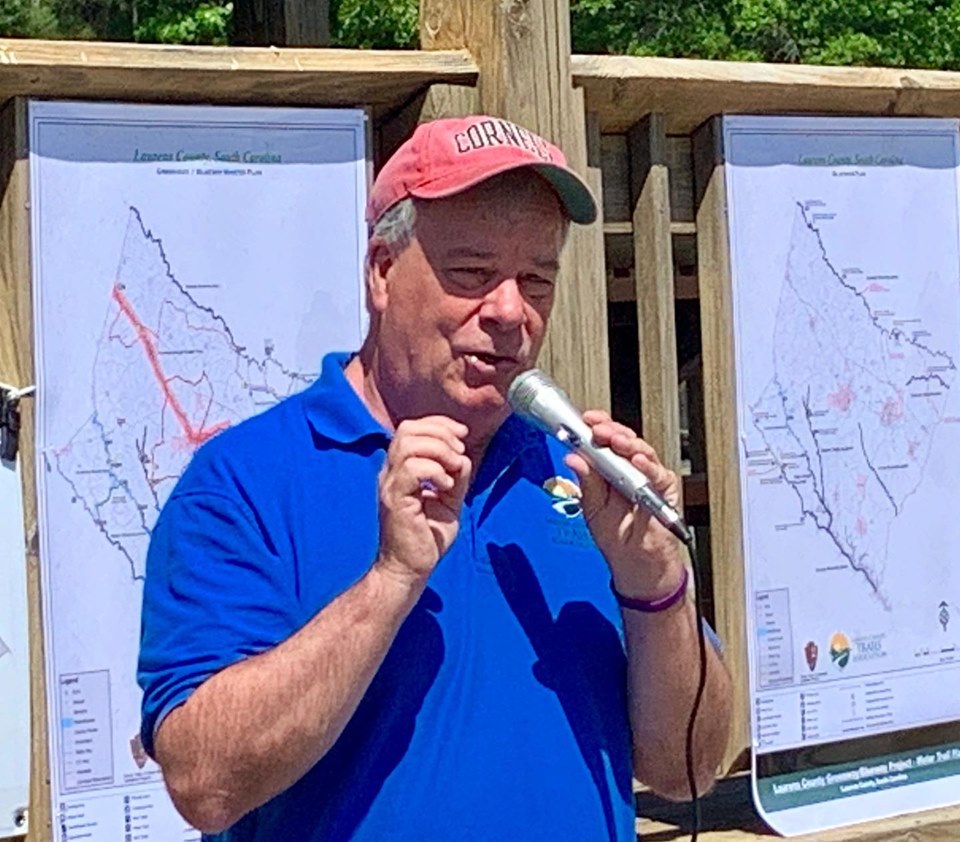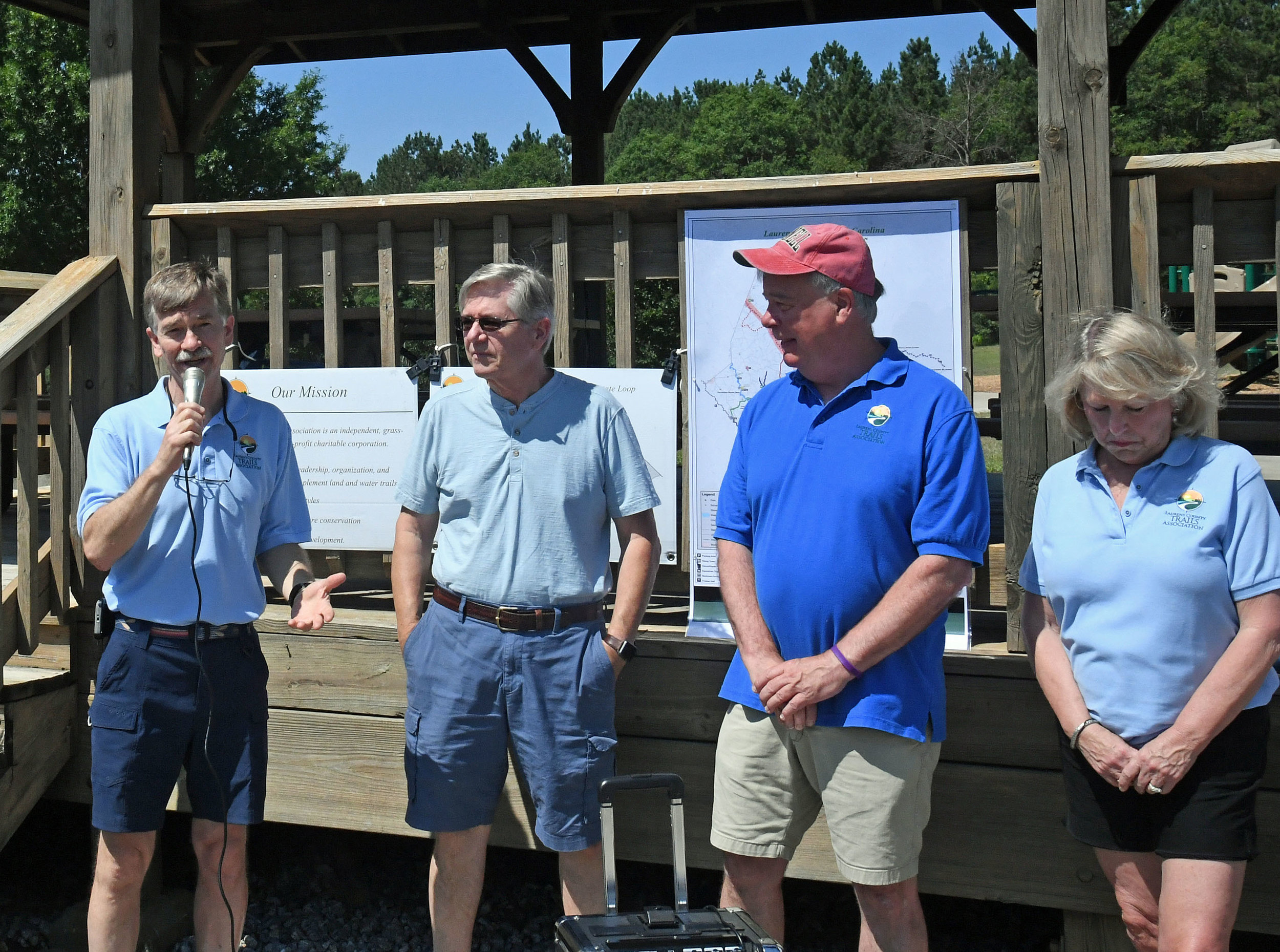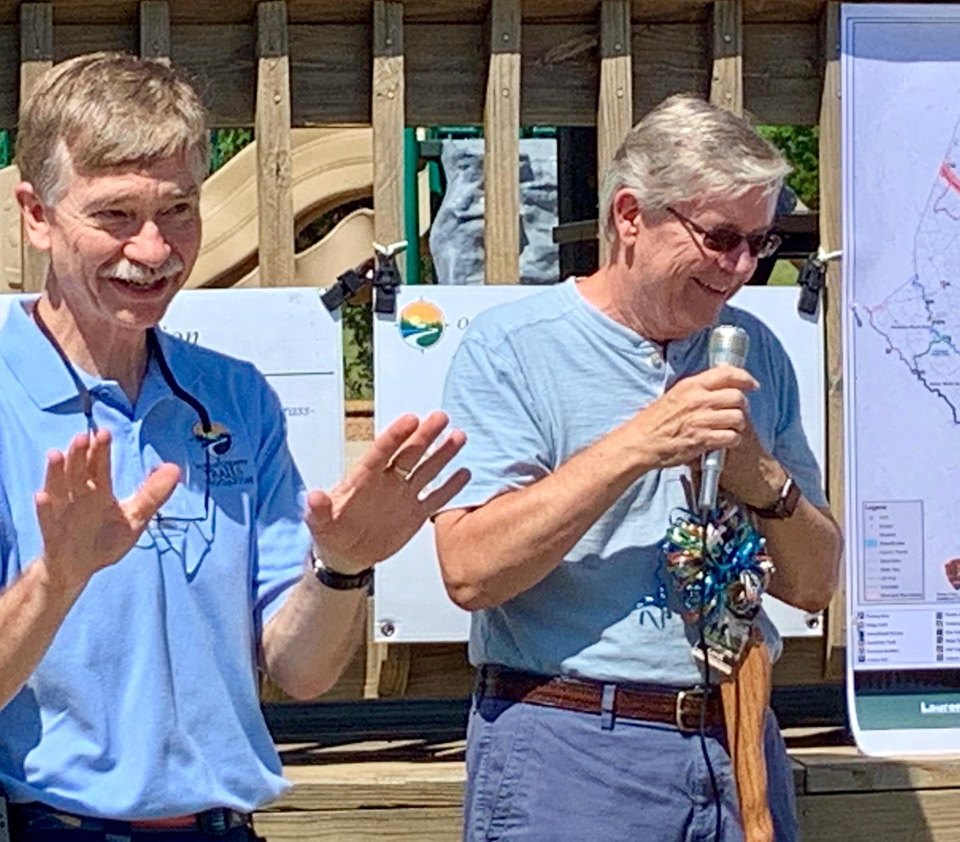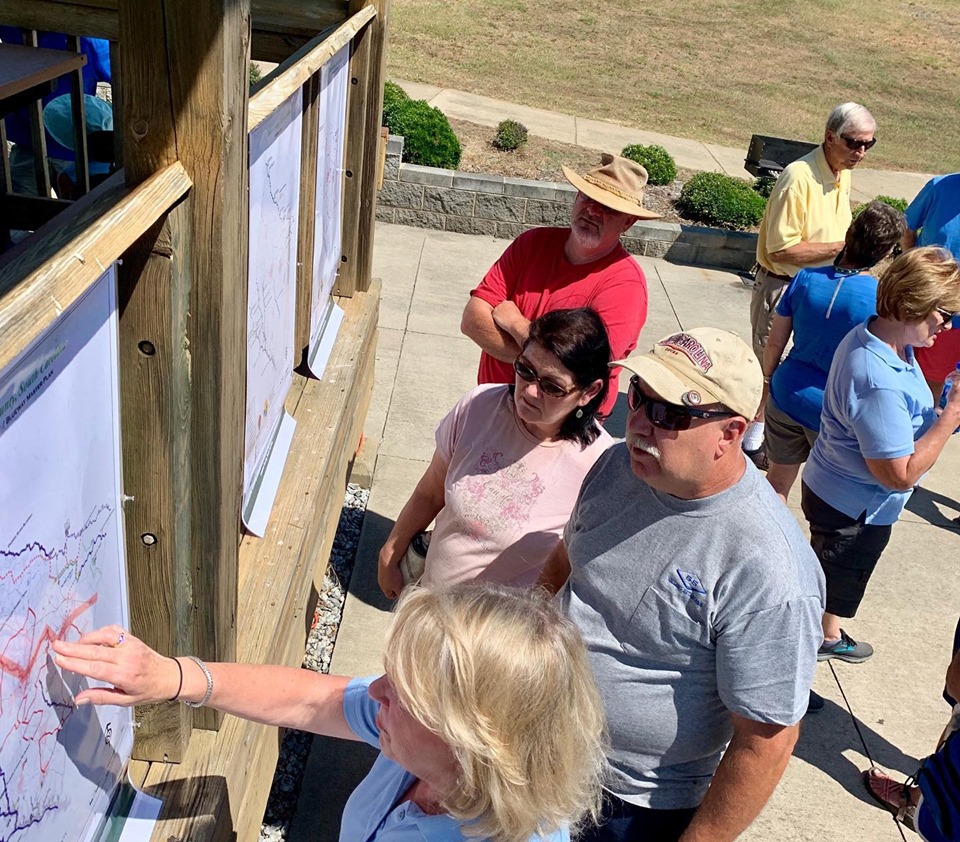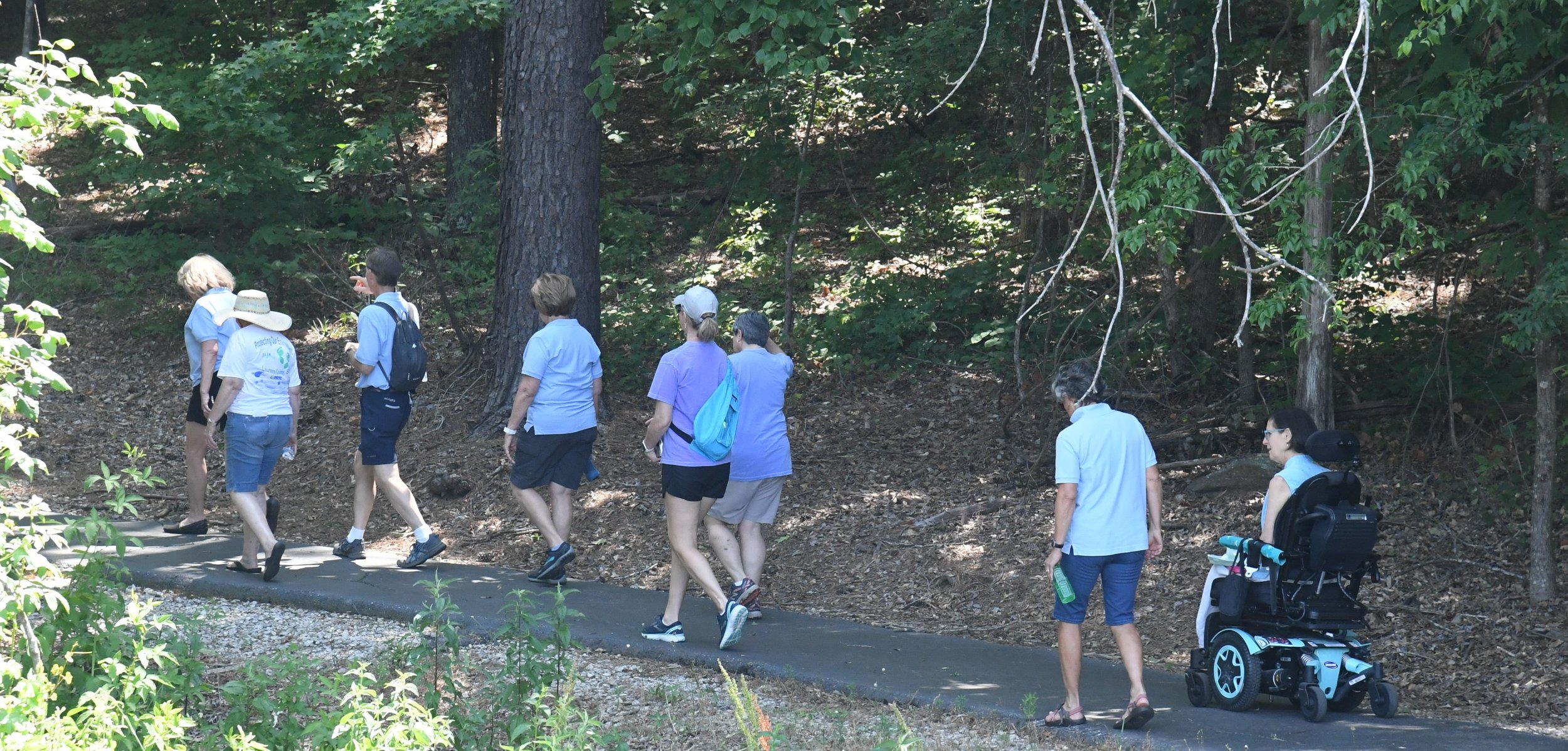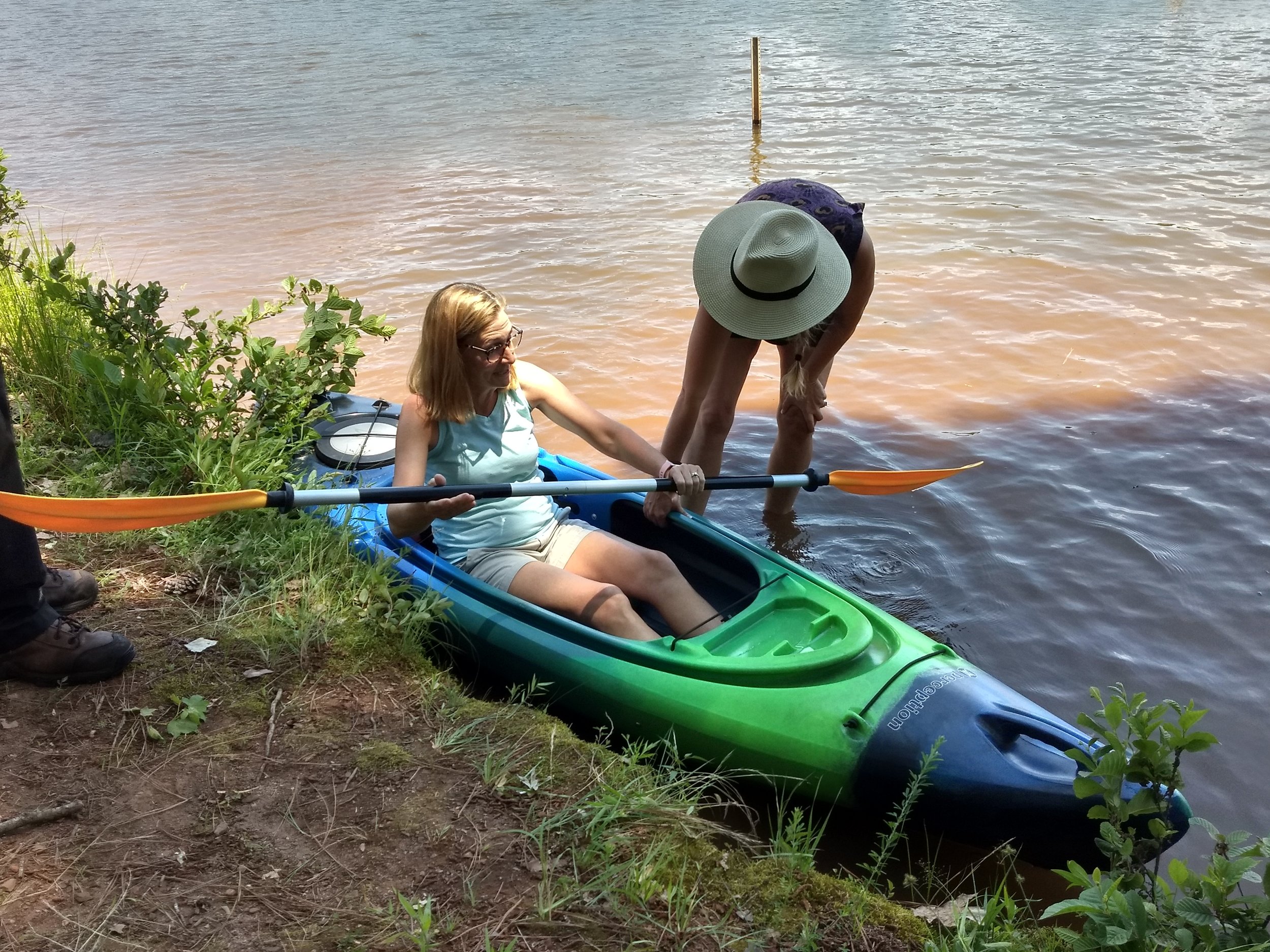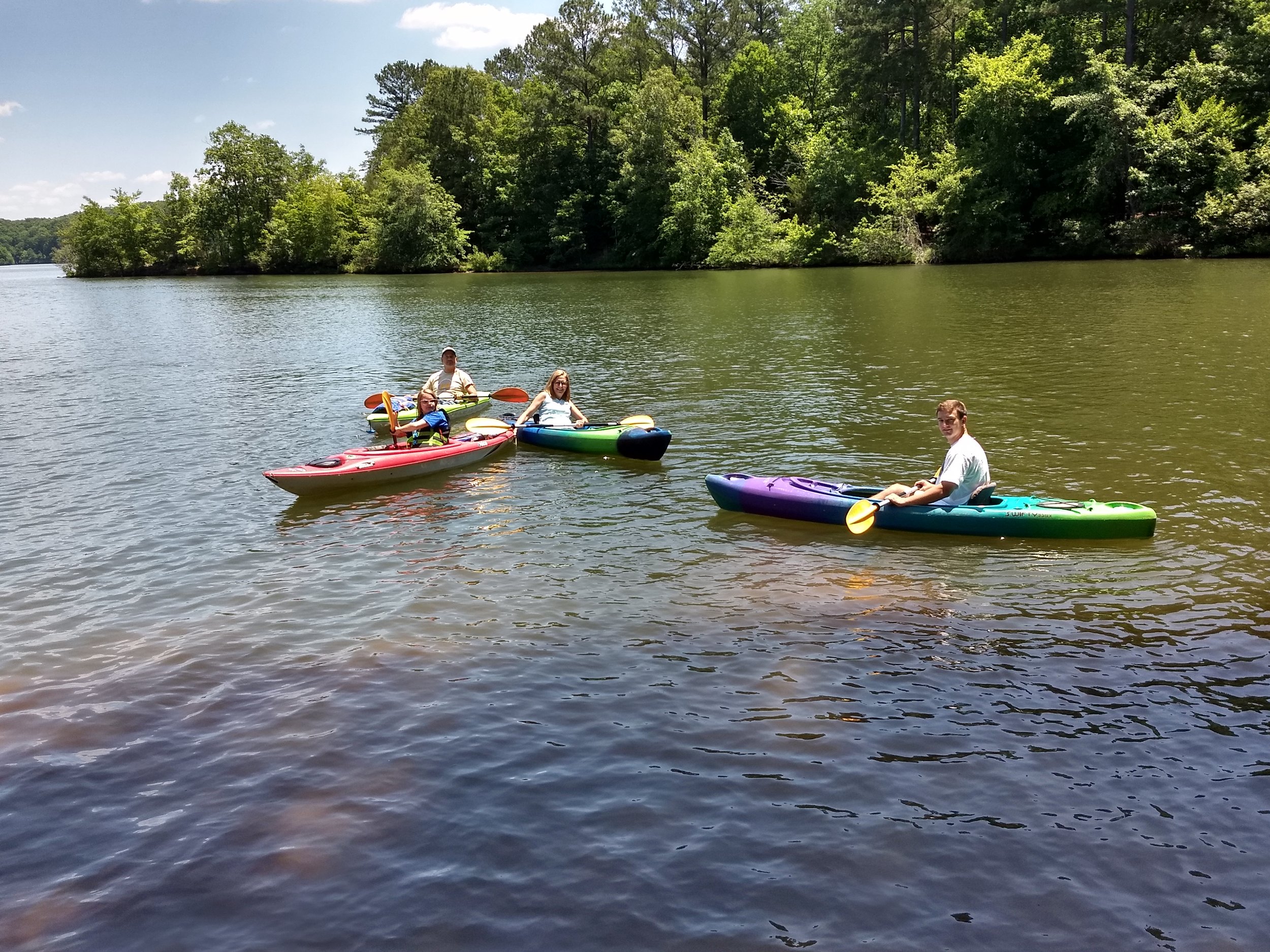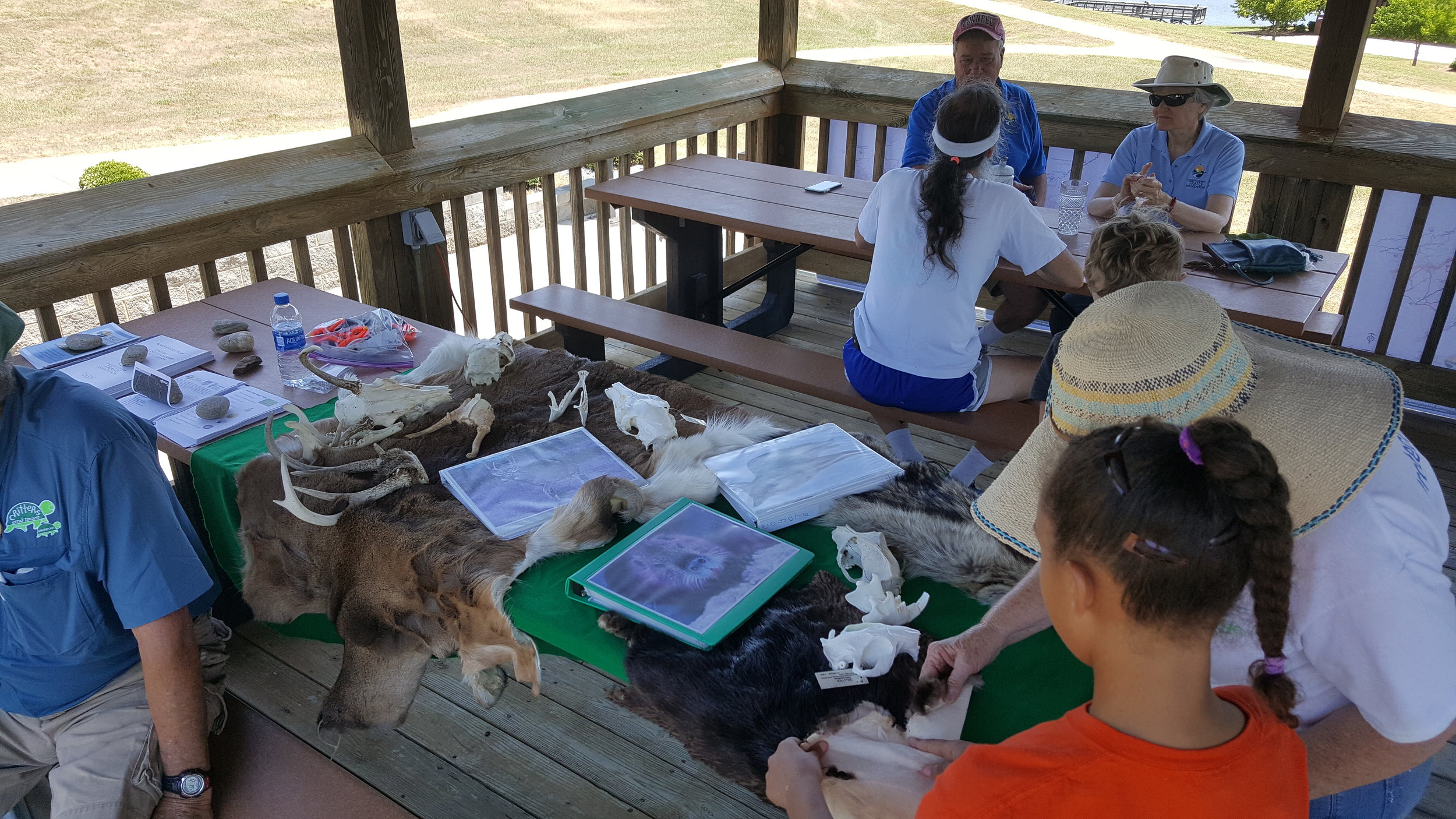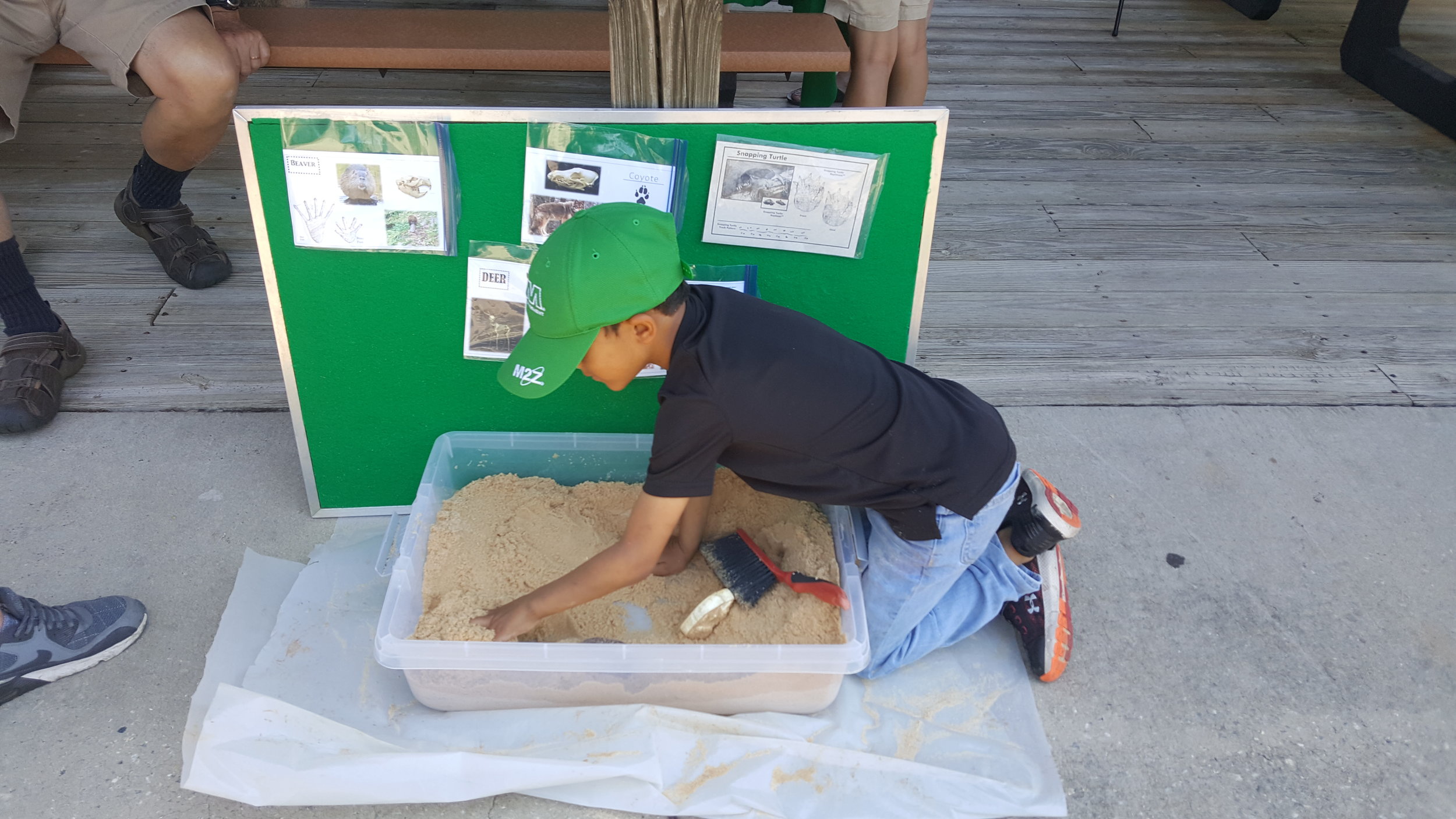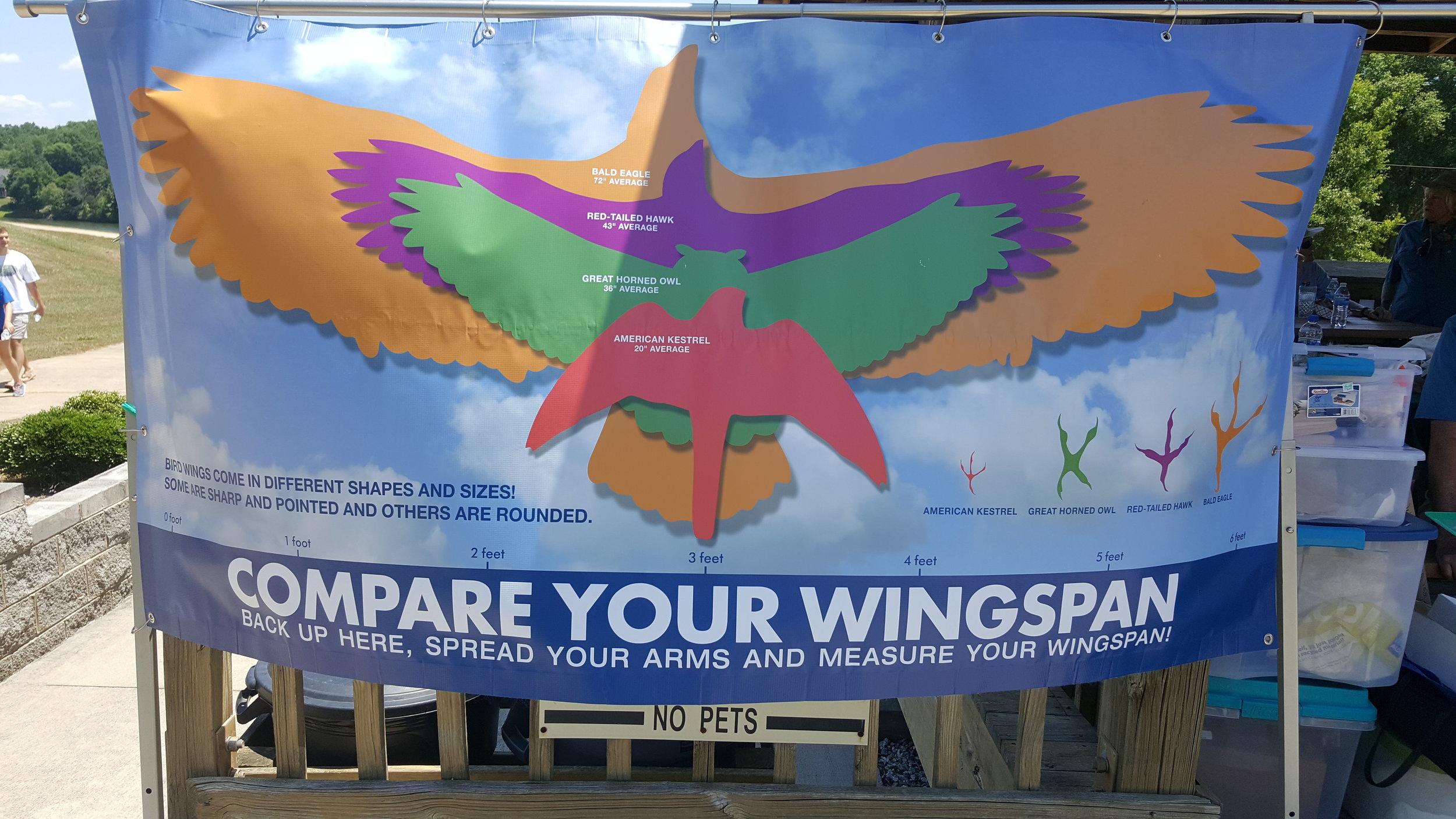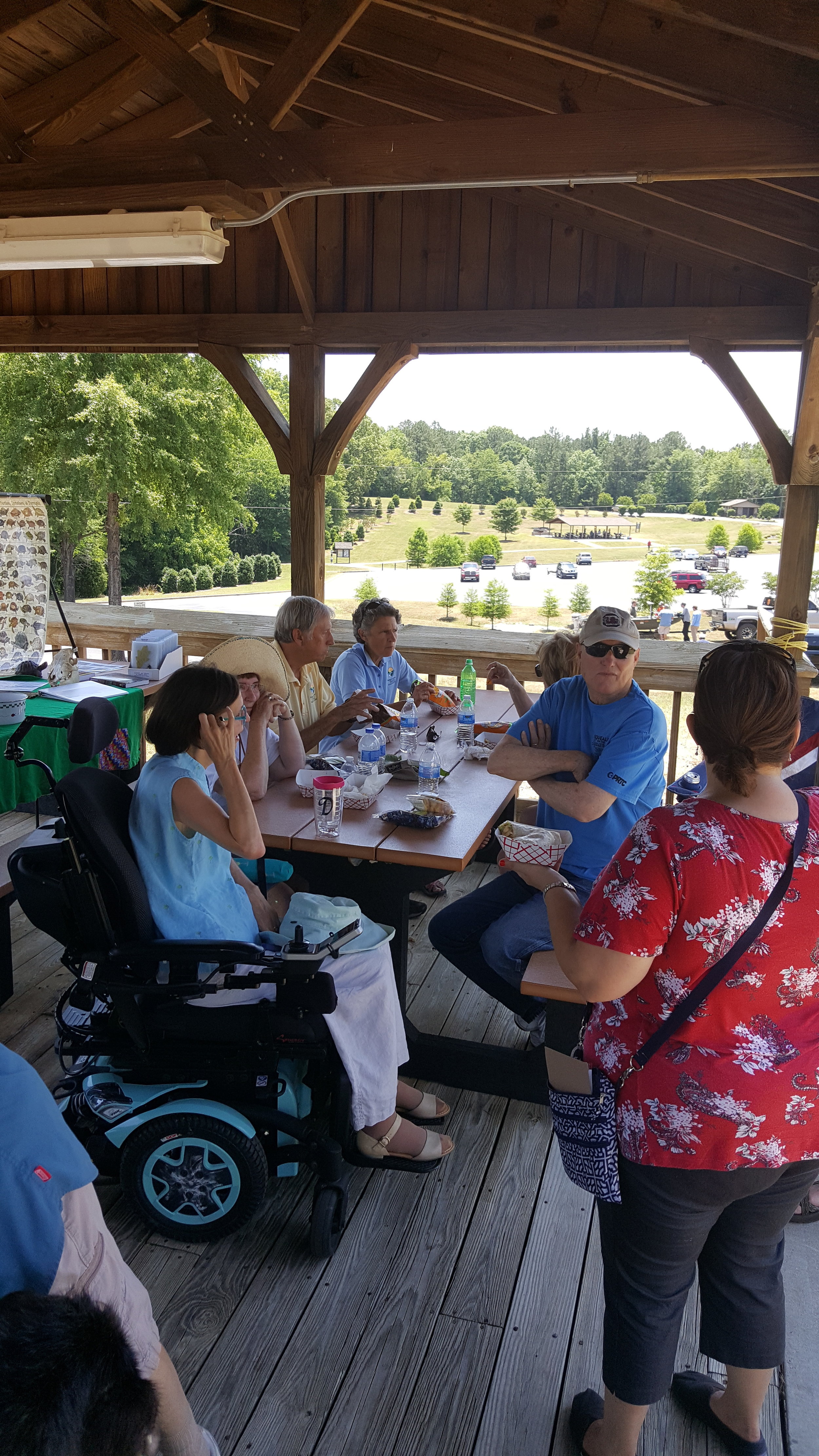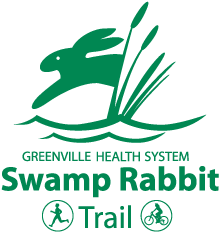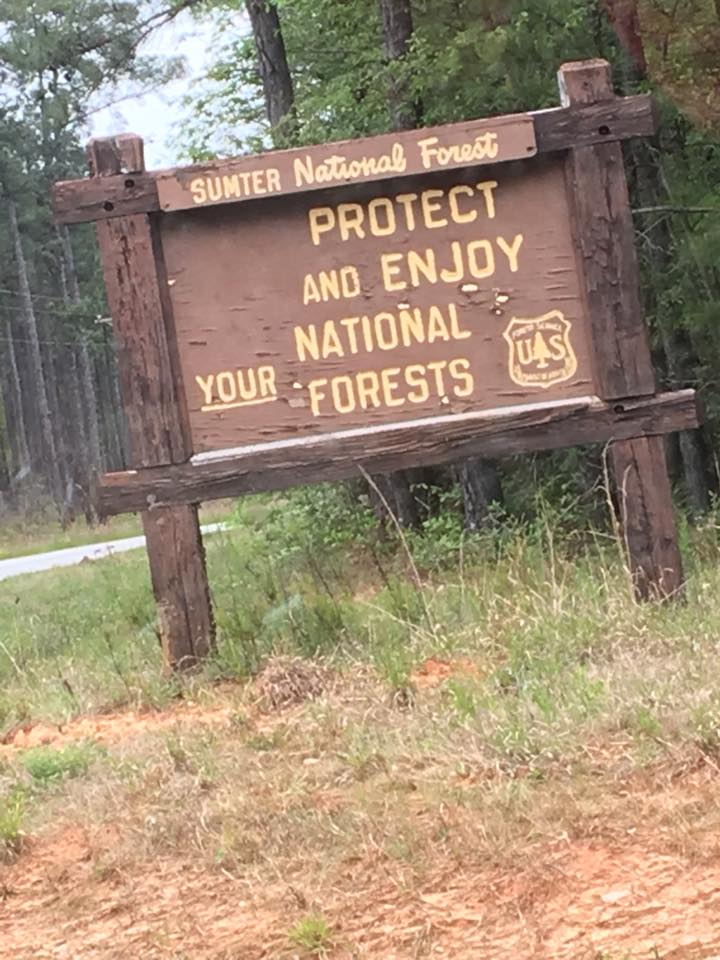If you're looking for a Fun Ride in Laurens County for this year's National Trails Day, Saturday, June 1, look no further.
National Trails Day 2019 and Laurens County Trails Celebration
The Laurens County Trails Celebration on National Trails Day, June 1, 2019, at Lake Rabon Park was another great step forward.
Thanks to everyone who participated and to everyone else who is supporting the development of trails of every kind in the county to improve personal health, promote economic development, conserve our natural resources, and raise the quality of life for all.
Special thanks to Laurens County Water and Sewer Commission, Prisma Health, Laurens County Chamber of Commerce, The Clinton Chronicle, The Laurens County Advertiser, WLBG, Critters and More On the Go, Asbury Adventures, and Marcus’ Barbeque.
Photos courtesy of Vic MacDonald, Amanda Munyan, and Bob Bryant.
LCTA Highlighted in Swamp Rabbit Trail Article
(Photo: MATT BURKHARTT/Staff)
Come on, Laurens County! Let's pull together and make it happen. Such a trail will improve the quality of life for us all. Click here to read the article!
National Trails Day
The first Laurens County Trails Day Celebration will be held on National Trails Day, June 1st, from 11:00 a.m. until 2:00 p.m. at our own beautiful Lake Rabon Park located on SC Highway 252 at 647 Lake Rabon Drive just 8 miles west of Laurens.
The Laurens County Trails Association, host of the event, will extend a welcome and offer an update on trails in Laurens County at 11:00 at Pavilion #1, and a guided 2-mile hike will begin around 11:30. Self-directed hikes and picnicking are possible throughout the park. Kayaking and paddle boarding opportunities will be provided by Asbury Adventures at a slight fee. Critters and More On the Go! will offer hands-on environmental education experiences, and Marcus' Barbeque will be on-hand, too. There are plenty of spaces for picnics on the park grounds and along the paved portion of the lake trail.
This low-key celebration is an invitation for everyone to be outside with family, friends, or on your own to enjoy some of our local natural treasures and trails--both paved and unpaved--that are suitable for all. There are plenty of spots for rest, relaxation, rejuvenation, and simple fun. Come spend a few hours or the whole day and show your support for developing trails in Laurens County.
Trails Association Names New Leader
The Board of Directors of the Laurens County Trails Association (LCTA) is pleased and excited to announce the election of Dr. T. Eston “Bud” Marchant as its new Executive Director. Through his successful career in education, Marchant brings a strong background in both academics and economic development along with a wealth of leadership experience.
Bud’s education includes a bachelor’s degree from USC; a Master’s in Education from Winthrop College, SC; Certificates from The Citadel and Harvard, and his Doctor of Education from the University of Sarasota, FL.
He has served at Beaufort Technical College, a Director at the College of Charleston, Dean at Anson and Stanly Community Colleges in North Carolina, and Vice President at Piedmont Technical College. On April 1 he will be retiring from his current role as President of the Carolina Community College in Sanford North Carolina and will assume his LCTA role in April.
Bud has always loved the outdoors, particularly enjoying hiking and biking. During his time in Charleston he recognized the power of trails in economic development and served as the director of economic development for the City of Beaufort and the Executive Director of the Greater Beaufort Chamber of Commerce.
Bud and his wife (now deceased) came to Laurens County over 20 years ago to run the Laurens County Higher Education Center. He said “We fell in love with Clinton’s small town charm and culture, and very quickly decided that this was the place we wanted to be.” In 2008 the Clinton Chronicle named him the Citizen of the Year in Clinton. He has always been active in community leadership, serving as the Chairman of the Laurens County Chamber of Commerce and the United Way of Laurens County. Currently he serves as the Chairman of the Laurens County Parks and Recreation Board.
In his own words, “The Swamp Rabbit Trail is an incredible driver of economic development in the communities it passes through. Laurens County has the potential to become the ‘Green Side of Greenville’ attracting growth and new residents.”
Bud will succeed Don Walker, who has served as LCTA’s Executive Director since it’s inception. Don and his wife will be moving to North Carolina in the near future and, between now and then, Don and Bud will work together to ensure a smooth transition.
From the Director: Don Walker
An Update on the Swamp Rabbit Trail and Laurens County
It’s been quite a while since you’ve seen an update but LCTA has been very busy. This update covers two topics: the need for volunteers to help with the GHS Swamp Rabbit Trail in Clinton and an update on progress on the Swamp Rabbit between Laurens and Clinton.
Swamp Rabbit in Clinton
Recently I met with Clinton’s Mayor Bob McLean, City Manager Bill Ed Cannon, and Harry Agnew. McLean and Cannon shared their interest in the trail, affirmed that the city is on board, and requested LCTA’s assistance in working on the plan. Since LCTA is fully loaded with working on the trail connecting Clinton to Laurens, we agreed that, with guidance from LCTA, a team of volunteers can get the job done.
The team will start by verifying the preliminary plan that’s already developed and then work out the details with property owners. Trail easements will also need to be established with those property owners. To do that, volunteers will need to be familiar with properties in Clinton and the people of Clinton, and be creative in working with people to identify alternatives when needed. A firm belief that the Swamp Rabbit will be good for Clinton and a desire to help make it happen are also essential.
So here’s your chance to really get involved and help Clinton. If you’re interested, or just curious, please call me or send an email so we can discuss it. Clinton needs you, so please help!
Swamp Rabbit between Laurens and Clinton
As mentioned above, LCTA has been nearly completely focused on the sections of the GHS Swamp Rabbit Trail that will connect Laurens to Clinton. The long term plan is to start there and then head in both directions: eastward through Clinton and on to the Palmetto Trail in Sumter Forest; and westward through Laurens and on through Gray Court to Fountain Inn. Obviously all of that will take many years to complete and we decided to start in the middle, connecting the two major cities.
It’s been a challenging process with a lot of steps. We defined a preferred route and then worked with attorneys to identify the owners of the properties along that route and to decide on the details of the easements needed through those properties. Discussions with those property owners revealed several results:
Many are very supportive because they recognize the value of having the Swamp Rabbit Trail on their property.
Some are supportive but for various reasons want the trail in a different place from what we planned. Then it might not connect with adjoining properties so new plans, and new discussions, need to happen.
In some cases we had not fully appreciated the problems with terrain (hills, wet areas) so plan changes were needed.
Others are undecided and need more time to think about it.
We even have one property owner that has moved, left no forwarding address, and cannot be found!
So this process is taking a lot longer than we had expected. Various situations require new plans but in the end it all needs to connect. So it’s become an iterative process that’s complex and time consuming but, like the dog that won’t let go of the bone, we’re hanging in there and making progress!
That’s it for now. Thanks for your interest and please contact me with any questions, ideas, or whatever!
From the Director: Don Walker
The Swamp Rabbit Trail and Laurens County
The GHS Swamp Rabbit Trail in Greenville County has provided significant health and economic benefits to Greenville County’s citizens and visitors. That’s why extending it through Laurens County is our top priority. Our initial plan is for the 6-mile section between Laurens and Clinton, alternating between natural beauty portions through fields and forests, and portions closer to businesses for economic development purposes.
Currently (April 2018) we’re getting ready to approach land owners to discuss their interest in the trail and the possibility of a trail easement on their property. We’re optimistic that property owners will be attracted to the benefits to them and to the community. The experience in Greenville and Spartanburg counties has shown that people living on trails are very happy to have such easy access and that properties on trails are in higher demand to buyers. We expect that discussions with property owners will take us into the summer and then engineering and construction can begin with a 2-mile stretch around and near the Laurens County Memorial Hospital.
After four years of planning we’re finally getting close to a real trail, so this is an exciting time for all of us at LCTA and hopefully for our friends and neighbors too. Thanks for your support and your patience and watch this space for information and updates.
Women Walk in the Woods
Just Do it!
Planning can drive you to excessively contemplate on the details of a simple act. The idea of women getting into the woods in Laurens County has been ruminating for sometime, but we just couldn't get it together. In frustration, darn it, a date and time was set. Sometimes, as Nike says, you have to "just do it!" Yesterday, Sunday, April 22nd at 2:00 pm, 4 Laurens County Women went walking in the woods. The hike was short but had impact. We walked 2 miles into the woods and 2 miles back out along the Enoree Passage of the Palmetto Trail. Yes, this trail does come through Laurens County and it is beautiful. The feeling of carrying out something that we have ruminated about for such a long time is awesome! Getting into the woods has more health benefits than you can imagine. According to a study published by the Proceedings of the National Academy of Sciences, nature experience reduces rumination and subgenual prefrontal cortex activation! Who knew!? Maybe our short little hike will help us disregard the planning and what-ifs of our second hike....stay tuned.
An LCTA Update!
Friends of Laurens County Trails Association
We hope that you’ve had a great spring and are looking forward to a summer filled with outdoor activities!
Here’s the latest news and happenings with LCTA:
We’ll have a booth at Heritage Hype in Clinton on May 20. Our theme is “Come play with us!” and we’ll be there to help you find hiking, biking, and water trails in our county. Heritage Hype is sponsored by the Laurens County Chamber of Commerce and features those businesses and organizations related to tourism and things to do in Laurens County. This year it’s being combined with Clinton’s annual Rhythm on the Rails festival, which is May 19-20 and includes over 60 vendors, 21 BBQ Competition teams, two days of free entertainment, live WSSL broadcast, rides and other events. For more information, see www.rotrclintonsc.com.
The Clinton Canopy group is excited to announce that the Millers Fork Trail will soon become a reality. A contract has been awarded to Darrohn Engineering and they will begin work soon. The trail is expected to be completed by August 1. Clinton Canopy expects there to be opportunities for volunteers to contribute to the project although the specifics have yet to be worked out. Possibilities could include grubbing out the section that extends beyond the utility right-of-way, or raking back excess mulch to clear the way for the trail bed, or building picnic tables, or planting trees. Perhaps you have special skills you can offer to the project. If you have ideas about how you can help, please contact me and I’ll get you connected with Clinton Canopy. For more information, see http://www.clintoncanopy.org/millers-fork/.
The LCTA Board has been very busy planning the route for the GHS Swamp Rabbit Trail through the County. We’ve focused on the cities of Laurens and Clinton, and the connection between them. Our initial priority is the connection between the cities, through the county, and are working with the county parks and recreation department to finalize the route. Our next step is meeting with land owners to discuss access agreements and then to apply for funding grants.
The state department of transportation (SCDOT) has agreed to place “Share the Road” signs along the 70-mile bike route that County Council approved last year. Our next step on bike routes is to determine whether we can place directional signs and to add the route to a smart phone app so riders can follow it.
The LCTA Board is delighted to announce the election of Norman Scarborough to our board. Norm is a professor of business and entrepreneurship at Presbyterian College, a former member of Clinton City Council, has been board chair of the Laurens County Health Care System and the Laurens County Community Fund, and has served on many other boards as well. He was named Clinton’s Citizen of the Year in 2009 and is committed to enhancing the quality of life in Laurens County by improving and developing all types of trails. If you see Norm, please welcome him to our cause.
Have a great summer and please contact me with your ideas, questions, or concerns. Stay in touch through www.lctrails.org and www.facebook.com/laurenscountytrailsassociation. Last (and probably least) if you have my email address in your contacts, please update it to donwalker@lctrails.org.
Don Walker, Executive Director
Laurens County Trails Association
PO Box 1492, Laurens, SC 29360
SUMMARY OF SUMMIT MEETING - At The Ridge of Laurens
Over 50 Laurens County leaders came together on the evening of November 17th at The Ridge of Laurens to decide how to extend the GHS Swamp Rabbit trail through the county. Participants included elected officials from the county and cities, various businesses, nonprofit organizations, municipal employees, the media, and the LCTA Board of Directors.
The underlying premise for the meeting was that the Trails Master Plan is completed and it’s time to turn our attention to implementation, which will be a huge, multi-year series of projects. Success will require commitment, participation, and collaboration from many people and groups across the county.
The goals of the evening were to initiate collaboration among county, cities, businesses, and community groups, to ensure that all have a common vision, and to establish the foundation for working together.
The Trails Master Plan for the People and Communities of Laurens County
To kick off the meeting, a brief summary of the Trails Master Plan was delivered. (The complete Trails Master Plan can be found at www.lctrails.org.) The vision promoted by the Plan is that Laurens County’s natural resources are an asset with value that can be captured and preserved (as opposed to an asset to be consumed). As such, Laurens County can become a green oasis, centrally located between the growing urbanization of Greenville/Spartanburg and Columbia/Lexington. Then the county can be a destination for outdoor enthusiasts seeking to escape the urban hustle, and a place where our own citizens can get outdoors to enjoy the peace and quiet of nature and improve their health.
The value has many facets. Certainly, economic development is key, as demonstrated by the success of Travelers Rest (more about that later). Other benefits include improved physical and mental health, a greater appreciation of nature and our county’s history, and off-road transportation opportunities for people to commute to work or school.
Laurens County’s rural, agricultural, and forested topology is an ideal basis for this green oasis. The county is rich in natural resources with abundant forests, ponds, lakes, rivers, wildlife, and plant life. In addition, we have many existing parks and trails, they just need to be connected.
Like any major endeavor, there are challenges to be met, but every challenge offers an opportunity as well. The overall health of Laurens County citizens is poor, relative to other South Carolina counties. Trails, whether walking, biking, or kayaking/canoeing, provide the opportunity for people to get outdoors for enjoyable exercise. Essentially no abandoned railways are available for us to use, but we do have utility rights of way, publicly-owned land, and private land owned by supportive people. Last but not least is the challenge of cost. Good trails are expensive to build, so a comprehensive capital fund raising campaign will be developed.
The Plan proposes many land- and water-based trails and the top priority is extending the GHS Swamp Rabbit Trail (GHS SRT) through the county. The goal is to connect with the existing GHS SRT in Fountain Inn, then go through or near Owings, Gray Court, Laurens, and Clinton, then head east to connect with the Palmetto Trail in Sumter National Forest. In addition, the Plan proposes on-road bicycling trails and water trails on the Enoree, Reedy, and Saluda Rivers. The Plan also proposes developing a plan for equestrian trails.
The Travelers Rest Story
We were delighted to hear about Travelers Rest (TR) from Dianna Gracely (TR City Administrator), Rebecca Cooper (TR City Council and President of the TR Chamber of Commerce), and Ty Houck (Director of Greenways for Greenville County). And what a story it is!
They talked about what it took to create a vibrant community in Travelers Rest. Certainly TR has enjoyed significant economic development since the GHS SRT was constructed: a recent study shows that, in one year, $6.7 million was brought into the region by visitors from outside the region. The SRT has been a key component of that growth, but it wasn’t driven by the trail alone.
To complement the trail, a multi-faceted plan was created. The plan was committed to balancing all elements of growth: retail, industrial, large commercial, and housing. Main Street was revitalized through streetscape improvements and the GHS SRT. Derelict and vacant properties were (and still are) redeveloped. A retail study was completed to determine which businesses they wanted based on leakage (businesses outside of TR that TR residents used because none existed in TR). That study led them to focus on businesses that provide food service and drinking, and clothing and accessories. Then those businesses were actively recruited through aggressive marketing and promotion. Finally, an emphasis on quality of life led TR to build amenities to attract visitors and recruit new residents. These include, among others, an outdoor amphitheater, parks, a farmer’s market, arts and crafts shows and running events.
Trail Construction Overview
Blake Sanders spoke to the group to help us get connected with what it takes to build a good trail. In his capacity as a Landscape Architect with Alta Planning & Design, Blake has done a lot of work on the GHS Swamp Rabbit Trail, the Doodle Trail, and many others. Blake is also the Mayor of West Pelzer, so he knows what it takes to get things done in a small town. He emphasized the engineering that goes into trail construction.
It starts with an understanding of the topology (elevation, rivers, roads, wetlands, other natural and man-made features) of the land so a route can be planned. Road crossings (traffic lights, crosswalks) and river crossings (bridges) need to be identified and designed. Designs are also needed for trail heads and parking, and the need for ADA compliance must be understood and designed. Storm water controls must be addressed, and signage must be planned.
The engineering process also covers maintenance plans, cost estimates, construction priorities, and the bidding and negotiation processes. Then construction itself can begin.
Conservation Easements
Our final speaker was Diane Culbertson, a longtime resident of Gray Court and a member of the Board of Directors for Upstate Forever, a nonprofit devoted to protecting the Upstate’s beautiful environment while supporting practical economic development. Diane has a lot of experience with conservation easements because she has used them herself.
A conservation easement is a legal agreement between a land owner and a non-profit (such as a land trust) to permanently protect the property from development in order to conserve the value of the land. The land owner retains ownership of the land and enjoys many of the current uses such as agriculture, forestry, residential, and recreational. What is generally given up is the right to subdivide the land or develop it for commercial or industrial uses.
Conservation easements are flexible and vary widely. Typically, the rights given up depend on the purpose of the conservation easement. Future owners are bound by the conservation easement’s terms forever.
The benefit to the land owner is tax deductions. The difference between the value of the land before the easement and the value after the easement is the basis for deductions on federal and state income taxes as well as reductions in property taxes and estate tax.
GHS Announcement
Rich D’Alberto, president and CEO of Laurens County Memorial Hospital, and Dr. Suzanne Smith, Chair of the Laurens County Memorial Hospital Board of Trustees, delivered an exciting announcement.
Through the GHS endowment fund, GHS donated $50,000 to the Laurens County Trails Association for the naming rights to the Swamp Rabbit Trail through Laurens County. Don Walker, Executive Director of LCTA, gladly accepted the donation stating that this affirms the continuing partnership already established with GHS. In addition, he confirmed that from now on, the trail will be called the “GHS Swamp Rabbit Trail” as is already the case in Greenville County.
In addition, GHS’ philanthropy department with provide leadership and assistance for developing LCTA’s Capital Fund Raising Campaign.
Breakout Groups
Attendees were then asked to provide their ideas and suggestions by joining one of six breakout groups: Implementation Priorities, Marketing & Promotion, Potential Partners, Financial Resources, Cost Management, or Community Engagement.
Implementation Priorities
The key question this group was asked to answer is: Where should trails work begin and what are the top 3 priorities?
The group concluded that we should start where there are the most people who would use the trail, not necessarily the easiest place. Forget starting in the middle of nowhere with few/no users. Focus on connecting Laurens and Clinton; go where the population is. The corridor between Laurens and Clinton seems like a natural place to start but make certain it is wide enough for people to bicycle.
Look at the heavy usage on W. Main Street in Laurens. There are broad, wide sidewalks and places to park at the county library, middle school, etc. It is safe and lighted. This is a model that works.
Use utility rights of way. CPW’s in particular are user friendly and can be bicycled for great distances. Most are beautiful woodland settings where you forget you are in the city. They can be low because of the need to use gravity (for piping sewer and water), but work around that issue.
Gray Court believes that in effect, they already have a section of the SRT because of the heavy use by cyclists on the main road through town (Old Laurens Road). They intend to someday have the SRT officially running through their town.
Try to capitalize on the jewel in the county that is Musgrove Mill State Historic Site. Continue the blue trails work; there is an interest.
Marketing & Promotion
The key question for this group was: What are the best ways to make the public, and tourists, aware of our trails, their value, and how to use them?
Before addressing that question, this group discussed the communication plan adopted by the LCTA Board of Directors in 2015-16 and learned of strategic actions already taken. Most items in that communication plan are done but some are still being worked on:
- Communication tools such as stationary, business cards, display booth, brochures, trail maps, etc.
- Media plan to include a monthly newspaper column, monthly radio talk show, news releases, etc.
- Online presence: website, Facebook page, Twitter account.
- Educate the community through lunch and learns, participation in countywide festivals and events with display booth, and other means.
Following this discussion group members collaborated and agreed on additional action steps to be taken:
- Social media avenues need to be continued to be explored and should include Facebook, Instagram, and Twitter. All should be cross referenced and linked together.
- The positive use of trails needs to be highlighted to the community. Citizens need to understand the benefits of trails, understand the leadership role of LCTA in making it happen, as well as the trail system in our county.
- All participants agreed that until there is a clear vision of what the GHS Swamp Rabbit Trail will look like and where it will go, people will not fully understand its impact.
- All participants agreed that before a Capital Fund Raising Campaign can occur, this trail vision has to be created and put together in a package that explains and offers a visual of how it will look. The group was pleased to learn that this vision will be created by GHS philanthropy and the LCTA board.
Potential Partners
This groups’ key question was: Whose help do we need to implement trails in Laurens County?
This group consisted of leaders in the community who want this trail to be a huge success. Ideas began with the common-sense approach that all of the local government agencies are on board. In addition we need to reach those potential partners outside of the municipalities, including:
- Our local School Districts and Presbyterian College to build a sense of urgency with our "future" trail users and possible partners.
- Our local plants and industries whose employees could use the trail as a daily way of green transportation to and from work.
- Our local YMCA's would be beneficial partners as well as the Eat Smart Move More group.
- Other outdoor or recreational partners could be the South Carolina Parks and Recreation Association and Clemson University's PRT department.
- Local civic groups include Rotary and Kiwanis as well as Ten at the Top, Upstate Forever, and the Upper Savannah Land Trust.
- Lastly we also need to incorporate our local churches, Realtor Associations and Mainstreet Organizations.
By covering this wide array of potential partners this will open the doors to others who were not discussed. This truly is a county-wide project and everyone's help is needed.
Financial Resources
This group’s key question was: Because on average, government grants cover 16% of funding for nonprofits and the other 84% must come from private donors and foundations, where will we get the money? Potential sources of funding were identified:
- GHS donation – a significant first step on which we must build.
- Target Laurens County industries such as Sterilite, ZF Transmissions, and others as well as small businesses and individuals. Possibly grant them subordinate naming rights to a section of the trail.
- Banks and other financial institutions.
- Key is intergovernmental cooperation: The cities of Clinton, Gray Court, and Laurens and Laurens County must work together as partners to accomplish trail goals, especially when applying for TAP and other grants.
- Seek in-kind donations or discounts from local vendors and contractors with which each local government entity does business.
- Hospitality tax and Accommodations tax revenue.
- Capital sales tax, but this would require a referendum.
- Allocations from Community Transportation Committees.
- Promote conservation easement incentives for local landowners.
- Also discussed was how to “pitch” the idea to potential donors:
- Stress positive economic impact. See Swamp Rabbit Trail statistics.
- Emphasize health benefits to all citizens.
- Improve quality of life across the entire community.
- Use as a business recruiting tool – quality of life, healthy lifestyle.
- For support of local citizens, promote idea of an “outdoor YMCA,” with no membership fee and available to all.
- Connect to the effort to recruit active retirees to Laurens County. Their number one activity is walking.
Cost Management
Key question: How do we minimize the costs to build and maintain trails while delivering a quality experience? This group focused on several concepts including:
- Gain the support of community and county entities that can construct trails, as opposed to contracting services from entities outside of Laurens County.
- Through local civic groups, churches, etc., explore partnerships for volunteer labor, both for trail development and ongoing maintenance. Also, local area trail clubs could be fostered to oversee care of particular portions of the trail.
- To reduce cost, initially pave only the sections where anticipated use is high, such as in Laurens and Clinton and perhaps between them. For other sections use a less expensive surface and then pave them later as funds become available.
- Construct the trail foundation initially so that all of it may be paved eventually.
- Consider developing dog parks near Clinton and Laurens.
Community Engagement
Key question: How do we engage the public? Ideas from this group include:
- The first priority is education, emphasizing how any of the various trail activities could have a major positive impact on our quality of life, personal wellness, and nature-deficit disorders. Some examples include losing weight, becoming active again, how outdoor fun activities and experiences can improve communication among married couples, and how time outdoors, away from computers and electronic devices, improve communication with children.
- Some government leaders in the group asked for trail events to be planned soon for their towns. One leader commented that to be the dream leader in recreation may cost you politically.
- Work with hobby groups. They are already organized, know what they need and want, and are willing to work together to make it happen.
- Sponsor trips to other successful trail sites that are similar to ours.
Wrap-Up
Everyone agreed that the time was well spent. Participants learned a lot and welcomed the opportunity to provide input. LCTA appreciated that input and will use the ideas and insights to develop its 2017 plan.
